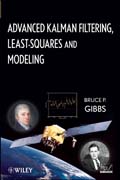
Advanced kalman filtering, least-squares and modeling: a practical handbook
Gibbs, Bruce P.
This book is intended primarily as a handbook for engineers who must design practical systems. Its primary goal is to discuss model development in sufficient detail so that the reader may design an estimator that meets all application requirements and is robust to modeling assumptions. Since it is sometimes difficult to a priori determine the best model structure, use of exploratory data analysis to define model structure is discussed. Methods for deciding on the “best” model are also presented. A second goal is to present little known extensions of least squares estimation or Kalman filtering that provide guidance on model structure and parameters, or make the estimator more robust to changes in real-world behavior. A third goal is discussion of implementation issues that make the estimator more accurate or efficient, or that make it flexibleso that model alternatives can be easily compared. The fourth goal is to provide the designer/analyst with guidance in evaluating estimator performance andin determining/correcting problems. The final goal is to provide a subroutinelibrary that simplifies implementation, and flexible general purpose high-level drivers that allow both easy analysis of alternative models and access to extensions of the basic filtering INDICE: Preface. 1. Introduction. 1.1. The Forward and Inverse Modeling Problem. 1.2. Estimation from Gauss to Kalman. 1.3. Filtering, Smoothing and Prediction. 1.4. Prerequisites. 1.5. Notation. 1.6. Summary. 2. System Dynamics and Models. 2.1. Discrete Time Models. 2.2. Continuous Time Dynamic Models. 2.3. Numeric Computation of the State Transition and Noise Matrices. 2.4. Measurement Models. 2.5. Simulating Stochastic Systems. 2.6. Common Modeling Errors and System Biases. 2.7. Summary. 3. Modeling Examples. 3.1. Angle-only Trackingof Linear Target Motion. 3.2. Maneuvering Vehicle Tracking. 3.3. Strapdown Inertial Navigation System (INS) Error Model. 3.4. Spacecraft Orbit Determination. 3.5. Fossil-Fueled Power Plant. 3.6. Summary. 4. Linear Least Squares Estimation Fundamentals. 4.1. Least Squares Data Fitting. 4.2. Weighted Least Squares. 4.3. Bayesian Estimation. 4.4. Probabilistic Approaches - Maximum Likelihood and Maximum A Posteriori. 4.5. Summary of Linear Estimation Approaches. 5. Linear Least Squares Estimation - Solution Techniques. 5.1. Matrix Norms, Condition Number, Observability and the Pseudo-Inverse. 5.2. Normal Equation Formation and Solution. 5.3. Orthogonal Transformations and the QR Method. 5.4. Least Squares Solution using the SVD. 5.5. Iterative Techniques. 5.6. Comparison of Methods. 5.7. Solution Uniqueness, Observability and Condition Number. 5.8.Pseudo-inverses and the SVD. 5.9. Summary. 6. Least Squares Estimation - Model Errors and Model Order. 6.1. Assessing the Validity of the Solution. 6.2. Solution Error analysis. 6.3. Regression Analysis for Weighted Least Squares. 6.4. Summary. 7. Least Squares Estimation - Constraints, Nonlinear Models and Robust Techniques. 7.1. Constrained Estimates. 7.2. Recursive Least Squares. 7.3. Nonlinear Least Squares. 7.4. Robust Estimation. 7.5. Measurement Preprocessing. 7.6. Summary. 8. Kalman Filtering. 8.1. Discrete-Time Kalman Filter. 8.2.Extensions of the Discrete Filter. 8.3. Continuous-Time Kalman-Bucy Filter. 8.4. Modifications of the Discrete Kalman Filter. 8.5. Steady-State Solution. 8.6. Wiener Filter. 8.7. Summary. 9. Filtering for Nonlinear Systems, Smoothing, Error Analysis/Model Design and Measurement Processing. 9.1. Nonlinear Filtering. 9.2. Smoothing. 9.3. Filter Error Analysis and Reduced-Order Modeling. 9.4. Measurement Preprocessing. 9.5. Summary. 10. Factored (Square Root) Filtering. 10.1. Filter Numerical Accuracy. 10.2. U-D Filter. 10.3. Square Root Information Filter (SRIF). 10.4. INS Example Using Factored Filters. 10.5. Large Sparse Systems and the SRIF. 10.6. Spatial Continuity Constraints and the SRIF Data Equation. 10.7. Summary. 11. Advanced filtering Topics. 11.1. Maximum Likelihood Parameter Estimation. 11.2. Adaptive Filtering. 11.3. Jump Detection and Estimation. 11.4. Adaptive Target Tracking Using Multiple Model Hypotheses.11.5. Constrained Estimation. 11.6. Robust estimation: H-infinity Filters. 11.7. Unscented Kalman Filters. 11.8. Particle Filters. 11.9. Summary. 12. Empirical Modeling. 12.1. Exploratory Time Series Analysis and System Identification. 12.2. Spectral Analysis Based on the Fourier Transform. 12.3. Autoregressive Modeling. 12.4. ARMA Modeling. 12.5. Canonical Variate Analysis. 12.6. Conversion from Discrete to Continuous Models. 12.7. Summary. 13. Software for Flexible and Efficient Execution. 13.1. Library. 13.2. Chapter 3: Modeling Examples. 13.3. Chapter 5: Linear Least Squares Estimation Solution Techniques. 13.4.Chapter 6: Model Errors and Model Order. 13.5. Chapter 7: Least Square Estimation - Constraints, Nonlinear Models and Robust techniques. 13.6. Chapter 8: Kalman Filtering. 13.7. Chapter 9: Filtering for Nonlinear Systems, Smoothing, Error Analysis/Model Design, and Measurement Preprocessing. 13.8. Chapter 10: Factored (Square Root) Filtering. 13.9. Chapter 11: Advanced Filtering Topics.13.10. Chapter 12: Empirical Modeling. Appendix A Summary of Matrix/Vector Properties. A1 Definitions. A2 Elementary Vector/Matrix Operations. A3 Matrix Functions. A4 Matrix Transformations and Factorization. Appendix B Probability and Random Variables. B1 Probability. B2 Random Variables. B3 Stochastic Processes. Appendix C Selected First-Principle Concepts. C1 Gravitational Acceleration. C2 Aerodynamic Forces. C3 Fluid Flow in Pipes or Ducts. C4 Saturated Hydrological Flow. C5 Heat Transfer. C6 Thermodynamics for a Control Volume. C7 Electrical Circuits. Appendix D Discrete-Time (ARMAX-type) Models. D1 Discrete-Time Models as Integrated Continuous Processes. D2 Autoregressive Process. D3 Moving Average Process. D4 Autoregressive Moving Average Process. D5 Autoregressive Moving Average Process with Exogenous Inputs. D6 Autoregressive IntegratedMoving Average (ARIMA) Process. D7 Discrete Model Summary. Bibliography.
- ISBN: 978-0-470-52970-6
- Editorial: John Wiley & Sons
- Encuadernacion: Cartoné
- Páginas: 640
- Fecha Publicación: 31/12/2010
- Nº Volúmenes: 1
- Idioma: Inglés
